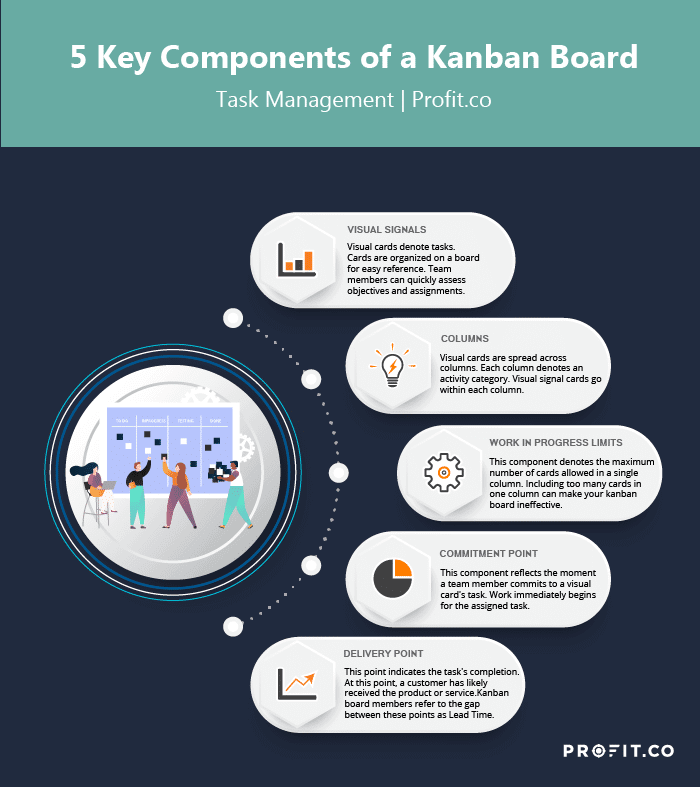A kanban board can transform your productivity. This visual approach to task management can assist with agile project management.
The Kanban methodology originated as a scheduling system for Toyota’s production system. Since then, the Kanban principles have reached marketers and business owners across the globe.
Agile projects rely on frequent deliverables for fast feedback. The agile approach contains many moving parts that can get lost in the shuffle. A kanban board complements agile projects by organizing important tasks.
Focus on being productive instead of busy.
What Is a Kanban Board?
A kanban board helps businesses and individuals visualize their workflow. You can organize each stage of an agile project and list steps for each stage.
A kanban board gives you greater clarity on your workload. This clarity can help you optimize different stages of your agile project.
A kanban board also keeps team members on the same page. A complex project with differing opinions can lead to confusion across the team. An agile project’s fast movement leaves little room for error. Greater clarity on the agile project leads to fewer roadblocks and enhanced productivity.
Profit.co’s task management module provides fully transparent task management for you and your remote team. Get started for free on Profit.co today!
Ready to start your OKR Journey for FREE?
Key Components of a Kanban Board

A kanban board comes with several components to boost efficiency for agile project management. Dan Anderson, the man who pioneered bringing the kanban method into the software services space, established five key components of every kanban board:
Visual Signals: Visual cards denote tasks. Cards get organized on a board for easy reference. Team members can quickly assess objectives and assignments.
Columns: Visual cards get spread across columns. Each column denotes an activity category. Marketing activities go in one column, while product management activities go in another column. Visual signal cards go within each column.
Work in Progress (WIP) Limits: This component denotes the maximum number of cards allowed in a single column. Including too many cards in one column makes your kanban board messy. If one column has too many cards, consider breaking it into two columns. WIP limits reveal workflow bottlenecks. You can spot opportunities to improve productivity.
Commitment Point: This component reflects the moment a team member commits to a visual card’s task. Work immediately begins for the assigned task.
Delivery Point: This point indicates the task’s completion. At this point, a customer has likely received the product or service. Kanban board members strive to transition from commitment point to delivery point quickly. Kanban board members refer to the gap between these points as Lead Time. They seek to lower Lead Time to complete tasks sooner.
A kanban board with these five components will improve task management. You can track progress in real-time and enhance your company’s workflow. Kanban board members can communicate with each other along the way to reduce Lead Time.
How to Create a Kanban Board
Some businesses aren’t sure where to start with the kanban methodology. The basic premise of a kanban board is a series of vertical columns.
You can create a kanban board using physical boards. Start by drawing vertical lines to distinguish columns. Label each column to match up with a work category.
You can use sticky notes as visual cards. Kanban board members can claim tasks by writing their name at the bottom of a sticky note. Moving sticky notes across columns demonstrates progress towards a task.
A physical kanban board comes without distractions. Employees can’t open up tabs or look at another window on their computer. When they look at the kanban board, they don’t look at anything else.
Unfortunately, this kanban board format is not realistic for remote teams. A physical board only works at the office or for personal use.
You can also create a kanban board using specialized software. We help businesses create kanban boards to boost productivity across their workforce.
After adding cards, you can assign them to team members. You can set a deadline for each task to prioritize urgent orders.
How to use a Kanban Board
Businesses can utilize Kanban principles for various initiatives. They can organize task management across agile projects. An organized workflow allows your employees to deliver products and hit milestones quicker.
You can review your board each week and conduct check-ins across your staff. These check-ins can address bottlenecks in your company’s workflow.
Some kanban boards allow you to integrate with popular apps. App integrations centralize information, saving your employees time.
To learn how Profit.co’s task management module can help your team boost productivity and achieve more, book a free demo with our experts!

